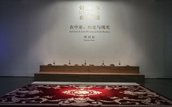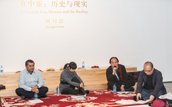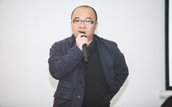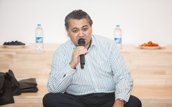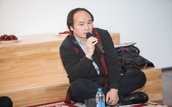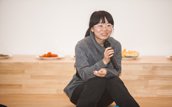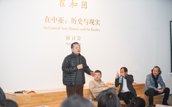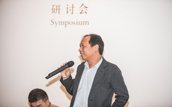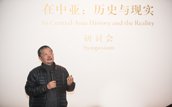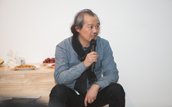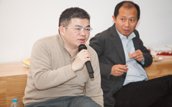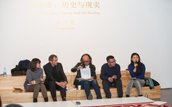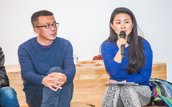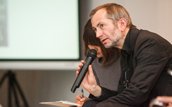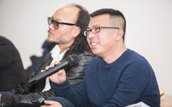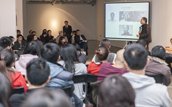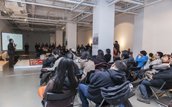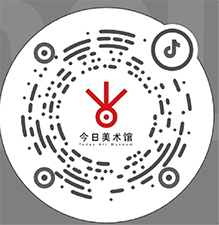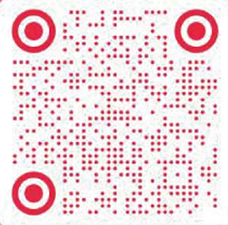Location: Beijing Today Art Museum
In central Asia: history and reality
Back
Duration: 2013-01-13
--
2013-01-13
Location: Beijing Today Art Museum
Location: Beijing Today Art Museum
Seminar Introduction
"Mr. Liu in hotan" is a scene painting artist liu xiaodong's project, by visiting the working method of the field, he found some mining YuGong in xinjiang's hotan and their families, to yulong kashi river as the background, on-site sketch, created four painting works, on August 25, 2012 to October 8 exhibited in urumqi international exhibition center. The mining and sales of hetian jade have formed an economic chain that affects different classes in the whole country. Starting from the low end of this chain, artists explore the economic and cultural connections between xinjiang, a unique region, and the vast inland with artistic methods.
To provide more in-depth thought resources for the project, the curators Hou Han as and nen launched a 10-day investigation, in northern xinjiang and southern xinjiang, respectively, visited many local writers, historians and folk artists, and in 2012 in urumqi on August 26, held "in xinjiang: art and society", the first round of the seminar on the basis of investigation and research, to mobilize more strength and wisdom to understand complicated history and reality in xinjiang to provide a diversified and interdisciplinary intellectual puzzles, and art in xinjiang were discussed from different aspects and the possibility of social interaction.
"Liu xiaodong in hetian" project will be exhibited in Beijing today art museum on January 12, 2013. Liu xiaodong will add more new painting works on the basis of urumqi exhibition, and the preliminary research and a lot of literature materials in the creation process of hetian will also be exhibited. At today's gallery, the second round of the workshop, titled "in central Asia: history and reality", will expand its scope from xinjiang to central Asia, from a broader geographical space and cultural context, to gaze at the academic issues raised by the "liu xiaodong in hotan" project.
Central Asia, geographically, refers to a vast area stretching from the Caspian sea in the west to China in the east, Afghanistan in the south and Russia in the north. It includes five former Soviet republics - kazakhstan, kyrgyzstan, tajikistan, turkmenistan, uzbekistan and Afghanistan, the khorasan region of eastern Iran, northern Pakistan, Mongolia, western China's xinjiang and Tibet, and southern Siberia. Historically, central Asia was dominated by nomadic peoples, and the region was an important part of the silk road. After the expansion of the turkic people, central Asia became the residence of various turkic ethnic groups, including kazakhs, uzbeks, turkmen, kyrgyz and tajiks. Therefore, central Asia was also known as "turkestan".
This region, once a meeting point of diverse cultures, began to share the same culture and religion in the long course of history, especially after islamization. This workshop in the first round, on the basis of the invited guests of different countries, are still using characteristic of central Asia space decorate a form, a distinguished guests and the audience sit on the floor in the carpet, in an open, easy and free atmosphere, concept of knowledge sharing and communication, hope can by Mr. Liu's creation for the ignition point, pouring out of a melting pot of ideas, and inspire wider knowledge about xinjiang and central Asia.
Guest
Unit 1: central Asian community host: ou ning, curator guest: arati asmu, uygur writer liu liangcheng, writer li Juan, writer
What are the common values in central Asia? How does this common value come into being? How does it affect the historical course and daily life of the region? How to gather the spiritual identity of people living together in this region? This unit will invite intellectuals and artists from different ethnic groups to discuss these issues.
Unit 2: mirror of history host:
What are the common values in central Asia? How does this common value come into being? How does it affect the historical course and daily life of the region? How to gather the spiritual identity of people living together in this region? This unit will invite intellectuals and artists from different ethnic groups to discuss these issues.
Unit 2: mirror of history host:

 Zhiguan: Wang Zimu Art Exhibition
Zhiguan: Wang Zimu Art Exhibition Seasons of Cezanne The Immersive Experience
Seasons of Cezanne The Immersive Experience Marie de Villein: Behind the Sun
Marie de Villein: Behind the Sun “一粒一世界——北京大学颗粒艺术展”
“一粒一世界——北京大学颗粒艺术展”
 Florentijn Hofman :Celebrate!
Florentijn Hofman :Celebrate! Li Nu: As if Sand Were Stone
Li Nu: As if Sand Were Stone Exhibition customization course | TIM YIP MIRROR children's art class
Exhibition customization course | TIM YIP MIRROR children's art class
 TAM Open Studio / Hello, New Friends
TAM Open Studio / Hello, New Friends WANG SHIKUO/TODAY ART MUSEUM YOUNG ARTIST RESIDENCY IN NEW YORK CITY
WANG SHIKUO/TODAY ART MUSEUM YOUNG ARTIST RESIDENCY IN NEW YORK CITY 2018 third wang shikuo award -- nomination exhibition of contemporary young artists
2018 third wang shikuo award -- nomination exhibition of contemporary young artists

